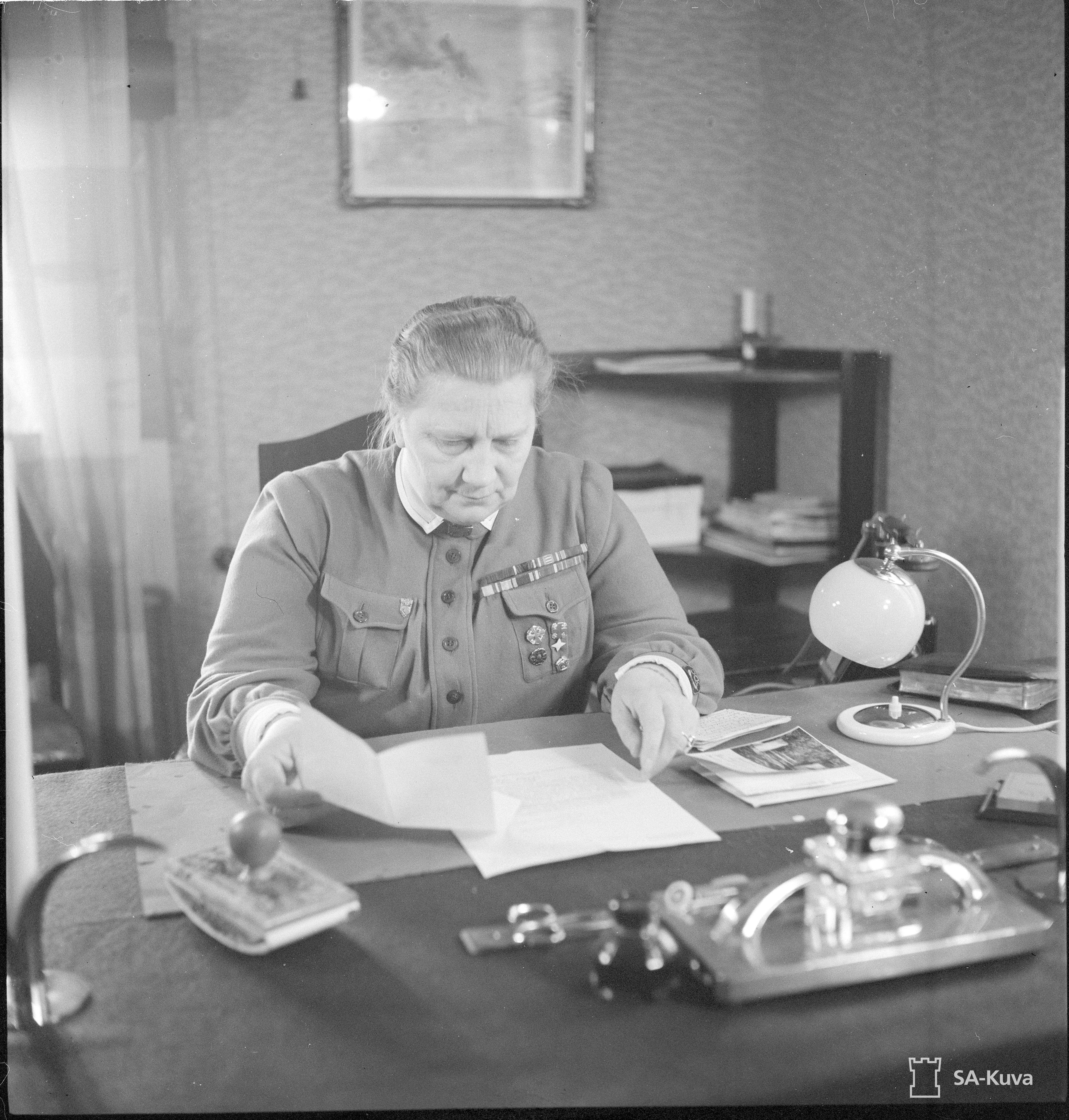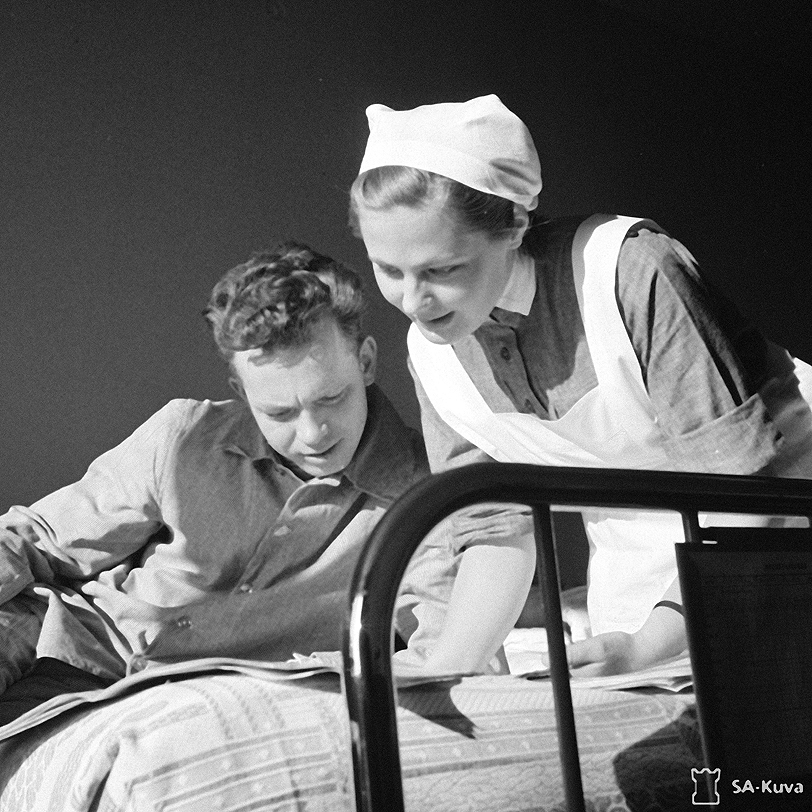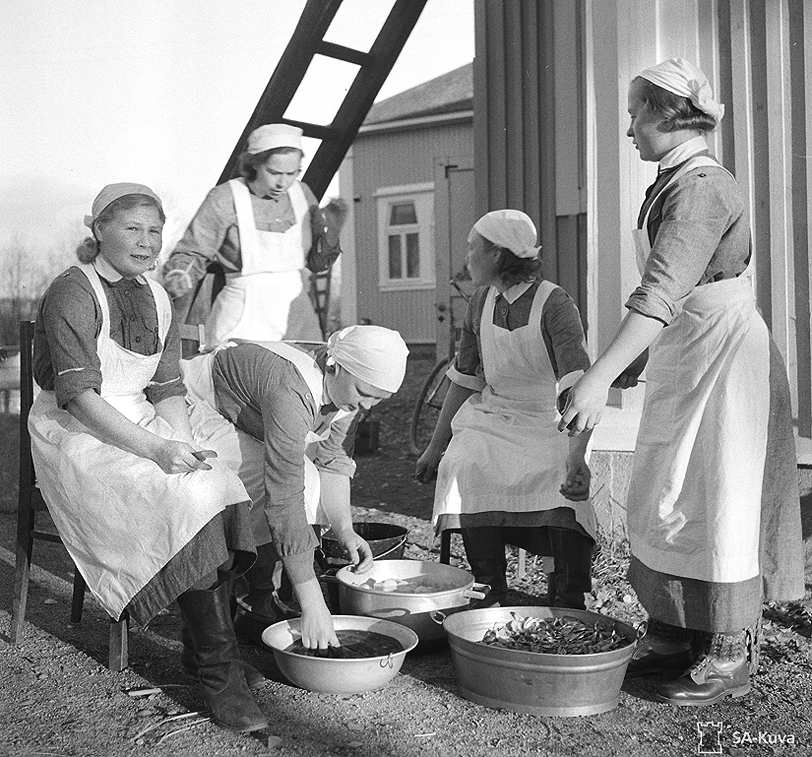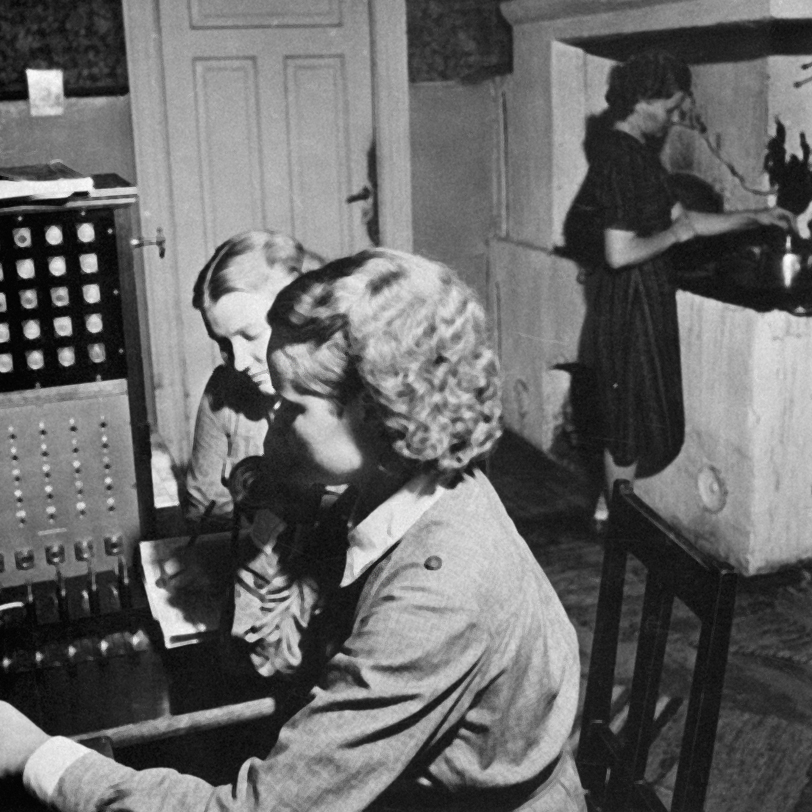Lotta Svärd
Lotta Svärd was the sister organisation of the Civil Guard, with an all-female membership. Lotta Svärd had prepared for military defence by training Lottas for medical, provisioning, equipping, office and fundraising duties. Shortly before the war, some of the Lottas from the fundraising division were trained as air surveillance and signal Lottas. The provisioning division had the largest number of Lottas. In practice, they were in charge of supplying provisions to the troops and departments under the Home Troops, among other things. The majority of the air surveillance Lottas worked as observers at air surveillance stations.
Lotta Svärd associations were established to support Civil Guard units
The commander-in-chief of the Civil Guard issued an order on 29 August 1919 in which he urged the local Civil Guard units to ensure that a Lotta Svärd association was established in their locality. The women’s divisions that operated in conjunction with local Civil Guard units were thus separated from the Civil Guard administration. The women’s associations established a nationwide organisation in 1921.
Goals of the operations as defined by the nationwide Lotta Svärd organisation
The goals of the organisation’s operations were defined in the organisation’s rules as follows:
‘The purpose of the Lotta Svärd organisation is to promote and strengthen the ideology of the Civil Guard organisation and assist it in safeguarding religion, home and the fatherland.
The “Lotta-Svärd” organisation shall realise this mission by
• working to raise the nation’s will to defend itself and the Civil Guard organisation’s moral condition;
• aiding the Civil Guard organisation’s medical activities;
• aiding in providing provisions to the Civil Guard units;
• aiding in the procurement of equipment for the Civil Guard units;
• aiding in the Civil Guard organisation’s office activities and raising funds for its own activities as well as for the benefit of the Civil Guard organisation.’
Structure of the Lotta Svärd organisation
The national Lotta Svärd organisation’s structure was similar to that of the Civil Guard organisation. The organisation’s senior management was formed by the board of directors, which comprised six permanent members and two substitute members who were selected by the annual assembly. The chair of the board of directors, i.e. the head of the organisation, was appointed by the commander-in-chief of the Civil Guards, who announced his decision to the annual assembly. The last person to chair the board of directors was Fanni Luukkonen, who also held the position for the longest period (from 1929 to November 1944).

Fanni Luukkonen, the chair of the Board of Directors of the Lotta Svärd organisation, at her desk. SA-kuva.
Number of members in the organisation
The Lotta Svärd organisation had a total of 105,000 members at the beginning of 1939. This number comprised almost 85,000 actual members, i.e. active Lottas, and a little under 20,000 supporting members. Approximately half of the actual members worked in the Provisioning Division.
The organisation comprised 22 Lotta districts. There were a little under 700 local associations and approximately 1,700 village branches. The last-mentioned were established in villages by the local associations.
Total work contribution of Lottas during the Winter War
Approximately 75,000 Lottas participated in the organisation’s work during the additional refresher training and the Winter War. The majority of them, approximately 50,000, worked as Lottas alongside their other activities. According to the studies of Vilho Lukkarinen, the total work contribution of Lottas during the additional refresher training and the Winter War was almost 4.2 million full working days during the additional refresher training and the Winter War.
Medical Lottas during the additional refresher training and the war

Photo taken during the Winter War. Place and date unknown. SA-kuva.
The Medical Division of Lotta Svärd set up eight field hospitals and nine field hospital wards during the mobilisation, which was called additional refresher training. The Finnish Red Cross set up another eight field hospitals. The two organisations were at first in disagreement over the placement of Lottas who had training in nursing. Lotta Svärd was assigned 200 nursing Lottas. At the start of the war, the organisation had 250 people who had completed a six-month-long assistant nurse course.
Approximately 7,000 of the Lottas in the Medical Division primarily worked in field and war hospitals. The majority of them had only completed short training courses. These medical Lottas performed a variety of assistance tasks, such as washing and repairing the clothes of wounded patients.
Provisioning Lottas were the most numerous

Provisioning Lottas peeling potatoes at the corner of the Heinjoki Civil Guard Building on 1 October 1939. SA-kuva.
In summer 1939, provisioning Lottas were in charge of supplying provisions to the volunteers who participated in the fortification of the Karelian Isthmus.
The provisioning Lottas of the Provisioning Division were in charge of supplying provisions to the troops who participated in the additional refresher training at the troops’ establishment locations. Provisioning Lottas already had Lotta canteens, which they had set up in different localities in peacetime for fundraising purposes. More canteens were also set up near the front during the war.
During the war, the Provisioning Division’s duties were performed by over 35,000 Lottas. Many of the division’s Lottas also worked in their home localities. At the start of the Winter War, the provisioning Lottas took care of the supplying of provisions to the higher headquarters, logistics facilities at the home front, depots, field hospitals, field hospital wards, hospital trains and troops manning the fortifications, among others.
Equipment Lottas worked to improve the troops’ equipment
Equipment Lottas participated in improving the soldiers’ clothing and maintaining their equipment. For this purpose, the Equipment Division set up workshops and laundry rooms. The Equipment Division was also in charge of organising the collection of clothing.
A little less than 18,000 Lottas were deployed as equipment Lottas, with over 3,500 of them deployed within the theatre of war and over 14,000 at the home front.
New operating areas of the Fundraising and Office Division
During the war, a little less than 7,400 Lottas engaged in the traditional work of the Fundraising and Office Division, with approximately 5,500 of them at the home front and a little less than 1,900 within the theatre of war. The division’s Lottas primarily performed office work at different headquarters. Others worked at logistics facilities and depots, among other locations.
Air surveillance and signal Lottas

Signal Lottas operating a telephone switchboard. Signal Lottas were also referred to as communications Lottas. Place and date unknown. SA-kuva.
The Fundraising and Office Division also included air surveillance and signal Lottas, who had completed special training. Almost 10,500 Lottas worked in air surveillance, with over 7,400 of them working at the home front and a little more than 3,000 within the theatre of war.
Air surveillance Lottas were assigned to regional air defence centres, air surveillance centres and air surveillance stations. Air surveillance stations, where Lottas worked as observers, were either tall buildings or towers that were built specifically for air surveillance purposes. Signal Lottas were assigned to signal stations and telephone switchboards at headquarters or similar locations. Signal Lottas also operated the telephone switchboard at the General Headquarters.
Ari Raunio
Source: Lukkarinen, Viljo, Suomen lotat (Lottas of Finland), Porvoo 1981.

 SUOMEKSI
SUOMEKSI PÅ SVENSKA
PÅ SVENSKA по-русски
по-русски